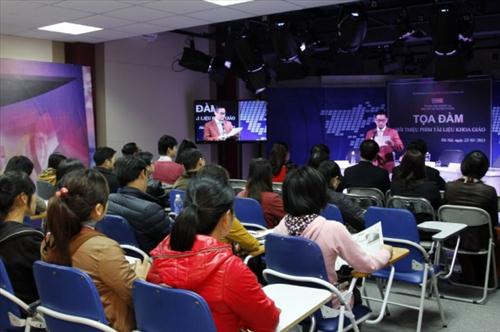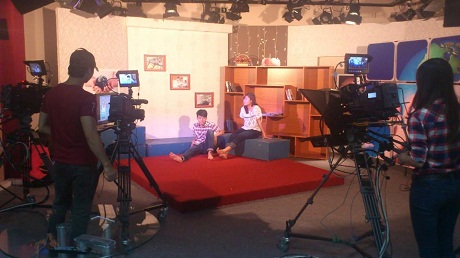
In an article congratulating Professor Ha Minh Duc - the first Dean of the Faculty of Journalism on his 70th birthday, I recalled the time when journalist Ho Tien Nghi - General Director of Vietnam News Agency visited and presented the faculty with an old typewriter. The presence of the old machine among the primitive things, as a symbol of science and technology for a field that requires practical skills. Thus, it is enough to see the shortage and extreme difficulty in organizing teaching in connection with the reality of life at that time. To have facilities, no matter how small or simple, to serve teaching, is still"chapi dream"always hidden in the minds of those who taught in the Faculty of Journalism at that time.
But then,"chapi dream"No longer sleeping, sleeping long. The persistence in mobilizing television units, the need to invest in this special field of study of the Party Committee and the Board of Directors of the school allocated a part of the budget to purchase equipment. Ten Zennit cameras were invested by the school, three M300 camcorders were given to the faculty by the General Director of Vietnam Television after the visit and work at the television station of the Professor, Head of the faculty. With a few initial facilities like that, and the purchase of a few more televisions, the school provided an additional office to practice journalism. This was the first step, clearly showing the development of the establishment of the Center for Journalism and Media Profession (CMP) later. Only a few years later, with the attention of the leaders of Hanoi National University and the Board of Directors of the University of Social Sciences and Humanities, exploiting investment sources from the World Bank, the faculty invested 1.7 billion VND in equipment television hook. However, the demand for training in the media industry is too great and the development of this industry is too fast, so 1.7 billion devices are like a drop in the ocean, students only skim the surface, do not have the conditions to deeply approach to create media products, but only watch through the screen, describe through images.

A recording session at CMP studio
In 2007, Hanoi National University continued to prioritize investment through science and technology projects. During the working session with the departments, member schools, including representatives of the University of Social Sciences and Humanities, agreed to no longer invest in small-scale projects, but to focus on investing in projects. The funding source was provided by the Ministry of Science and Technology. To anticipate the project, the school decided to establish the Center for Journalism and Communication, a unit under the school, operating under the direction of the Board of Directors, with its own charter with the following functions and tasks:
- About function:
a) Organize professional training and practical skills for students of the Faculty of Journalism and Communication, University of Social Sciences and Humanities.
b) Provide communication services to individuals, agencies, unions, and social organizations in accordance with the provisions of law and the School.
c) Introduce and promote the school's brand and Hanoi National University.
- About the mission:
Including training skills, tasks, and practical work for students and trainees of all systems according to the program framework; Arranging study schedules, locations, and technical equipment for studying and teaching; Developing investment plans for equipment and facilities to serve the Center's activities; Organizing short-term training courses on journalism and media skills and techniques; Producing media products according to partners' requirements according to current regulations, etc.
To concretize the above tasks, the Center proposes to the School on building human resources in the short and long term. Organizing training and practicing production of press and media products; Using invested equipment effectively. Currently, the Center has 9 people, including the Board of Directors: 3 people; Website working group: 3 people; Radio and television team: 3 people; Office and technical team: 2 people. In addition, the Center has 10 teachers who regularly write articles for the Website; There are dozens of collaborators who are students of the Faculty of Journalism participating in communication activities for the school and its member units, VNU.
The first phase of the investment project has brought remarkable results. Technically, a complete synchronous system of television and radio equipment has been installed, including: Studio practice room with a modern equipment system that can organize product development, organize presentations, seminars, and discussions with equipment support. The broadcasting system includes recording, pre-production, and post-production directly on the machine. This synchronous equipment system allows for closed production from the first stage to the final stage of completion, publishing on the School's website, and press agencies in need.
- About efficiency:
Every year, the center has participated in training and provided training services for over 200 students and trainees in journalism majors, with nearly 1,000 hours of practical teaching on television, radio, print and online newspapers.
Every year, the Center publishes over 1,500 news articles, announcements, and thesis information on the School's website, about daily activities and professional and academic exchanges related to the field of humanities.
The Center for Journalism and Communication has become one of the key units in carrying out communication work to promote the image of the School and VNU. Many key communication programs such as organizing communication events to welcome domestic and foreign leaders, political and union events of the School such as: Event to welcome Chinese Prime Minister Li Keqiang; Welcome the Prime Minister of the Republic of East Timor; Event to welcome Governor General of Canada; Event to welcome Chairman of the National Assembly (now General Secretary of the Communist Party of Vietnam) Nguyen Phu Trong; Welcome President Truong Tan Sang; Welcome Prime Minister Nguyen Tan Dung to visit and attend the opening ceremony of the new school year of VNU. Welcome and report on hundreds of international guests visiting and attending international conferences organized and co-organized by the School.
The Center has organized the production of traditional film products, Serial portraits of scientists broadcast on the program "Our Hanoi" and reports "Organizing entrance exams according to the capacity of the National University". System of lectures, practice exercises broadcast by Video clips. Support communication for units in the school. Publish reports of 10 typical annual events.

It is noteworthy that most of the media products are made by students who are CMP collaborators under the guidance and advice of teachers. There have been dozens of products in the form of video clips that have been defended and highly appreciated by the graduation thesis evaluation board. Notably, two students, Ha Thai class 53 and Ha Le Diem class 54, were awarded the Silver Kite Award by the Cinema Association in a national competition organized by the Cinema Association - Both of them are CMP collaborators.
The Center has organized the writing of nearly 100 portraits of outstanding teachers and scientists to be published on the Website to celebrate the 70th anniversary of tradition and the 20th anniversary of the founding of the Hanoi University of Social Sciences and Humanities.
Cooperate with partner agencies such as Doji Group; Vietnam Chamber of Commerce and Industry… in organizing and consulting on event communications.
The results achieved prove that the project investment is effective and correct. Based on the completed phase 1, VNU continues to invest in phase 2, adding equipment to build a virtual studio and a server system to store and distribute data information to units in need.
In the coming years, the perception of the center's development will focus on the following perspectives:
- Building a journalism and media training model of "practical learning - practical work", maximizing human resources, creating mechanisms and promoting pioneering innovation. The CMP Center environment emphasizes equipping students with knowledge, training methods, working skills, independent research, and creativity. It is a bridge of cooperation, connecting businesses with training institutions to develop in the direction of businesses operating in a research university environment.
- The orientation of the communication role that the Center undertakes is to combine internal and external communication so that society can correctly recognize and understand the brand, position and contributions of the University of Social Sciences and Humanities. Identify 7 main communication target groups of the University, which are also the targets of communication and public relations work: (Government and agencies, students, lecturers, specialists, alumni, businesses - community). In addition, the University of Social Sciences and Humanities has the advantage of being one of the largest journalism and communication training institutions in the country, and has been initially equipped with a system of modern machinery and equipment to produce communication products, but it also needs to have its own creative communication methods. If it makes good use of the existing facilities and human resources to build its own communication channel for USSH to promote its image, it will be more effective and less expensive than "relying" on mass media.
- Create the core difference of media products inherited from the traditional foundation. The core factor that makes up the School's brand is ultimately the quality of training, educational products, and research. This is the basic premise to create the difference, position, and prestige for media products. Media strategy, media products, and media orientation must clearly demonstrate the role and goal of promoting cultural values and national identity, fostering patriotism, national pride, and promoting social development for the long-term, sustainable development goals of the country.
The future is full of opportunities but also challenges for those working in journalism and media training in general and at CMP in particular./.
Author:MSc. Pham Dinh Lan
Newer news
Older news